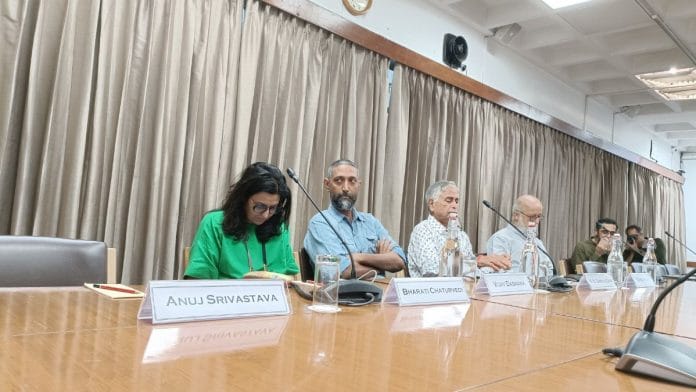New Delhi: The idea that ‘everyone knows how to plant trees’ should be dispelled as soon as possible, said ecological restoration professional Vijay Dhasmana. Standing on the podium at the India International Centre, Dhasmana launched into a description of what rewilding or restoration of landscapes actually entails, how it isn’t just planting trees, and what went into rewilding his magnum opus project—the Aravali Biodiversity Park in Gurugram, formerly a mining site.
“I have been sharing this story around the country for the past 10 years, but I never tire of it,” said Dhasmana at his talk titled ‘Healing a Landscape: Rewilding Aravali Biodiversity Park’ earlier this month. The story he told was one of a city coming together to restore an old mining land into a native forest. Their efforts eventually earned the Aravali Biodiversity Park India’s first Other Effective Area-based Conservation Measures (OECM) tag by the International Union for Conservation of Nature.
In 2009, the 380-acre degraded mine site situated between Gurugram and Delhi caught the eye of iamgurgaon, a citizens’ movement that wanted to plant trees in the area and add to the city’s green cover. When they approached Dhasmana, he was fascinated to see the geography of the region—the layered landscape of the Aravali, one of the oldest mountain ranges in the world, clearly displayed its sedimentary origins. However, the area was overrun by invasive species like vilayati kikar (prosopis juliflora), following which iamgurgaon gave Dhasmana one mandate—to make a city forest.
“The group didn’t have an MOU with the government, and didn’t even know they needed it,” said Dhasmana with a laugh. “They asked me, ‘Who will stop us from doing something nice?’”
As it turned out, quite a few people did. The journey to convert the former mining yard into a lush green forest with native species like dhok trees and fauna including nilgai and Indian small civet was not an easy one. Multiple times they encountered government officials telling them to pack up their project, asking why they were not planting “tall trees”, or proposing a six-lane highway right through the middle of the forest.
“When we started our project in 2010, several locals asked me whether they’ll even be able to see a forest in Gurgaon in their lifetime,” said Dhasmana. Now, with a smile on his face he clicked through the before-after pictures of the land, letting the audience see for themselves the result of his work.
Also read: Mahabharata to Mughal Empire—a 1,000 years encapsulated in the new Humayun Museum
Fear, not entitlement
In his presentation, Dhasmana clearly outlined his philosophy for ecological restoration, and how it depends on the needs of the environment, as well as the people. He recalled how during his work in Aravali, he got calls from DLF asking if he wanted the “300 trucks of soil” they had dug up from a construction project.
“They said the Aravalis’ landscape is just rocks so no plants will grow there, and I should put a layer of soil on it first,” said Dhasmana, amid the chuckles of the crowd.
However, Dhasmana’s vision was to rewild the area in the fashion of the original vegetation in the Aravali ranges across Haryana, Delhi, and Rajasthan. From sturdy trees like dhau and salai that thrive on sloping hills, to others like kaim and babool that are better suited for the valleys—Aravali have numerous native species, and Dhasmana, with the help of the people of Gurugram, brought them to life in the biodiversity park.
Corporate offices, school children, and resident welfare associations all came together to organise tree plantation drives and slowly help green the space with Dhasmana’s team. They understood the vision for the park, and now it is filled with more than 300 species of native trees.
Dhasmana’s talk was followed by a panel discussion with Bharati Chaturvedi, founder of Chintan group, and Sohail Hashmi, heritage conservationist, writer, and filmmaker based in Delhi. Their conversation went beyond just the example of the Aravali Biodiversity Park, and touched upon other urban forests and urban ecology in general in Delhi.
Chaturvedi urged audience members to do their bit and try to plant native species in their own gardens, moving away from the ornamental ficus plants. Hashmi criticised the ‘greening’ practices of agencies like the Delhi Development Authority in the Sanjay Van. Many times, they plant non-native, invasive species like vilayati kikar because it grows fast and increases tree count on paper, but does not add to the ecological value at all.
Hashmi said the purpose of urban forests go beyond just beautification of the commons. They’re supposed to belong to the ecology and the wildlife with humans just as guests, not the other way around.
“It is a real jungle when humans enter it with fear, not entitlement,” said Hashmi.
(Edited by Aamaan Alam Khan)






